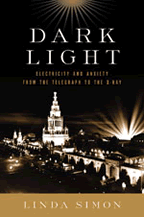When electric light was a scary idea
 Monday, August 16, 2004
Monday, August 16, 2004 A book explores why people took decades to plug into having current in their homes

Dark Light
Electricity and Anxiety From the Telegraph to the X-RayBy Linda Simon
Harcourt 368 pp. $25
Reviewed by Richard Di Dio
Philadelphia Inquirer - Monday August 16, 2004
Snap, crackle, zzzzzap! Electric power lines hum with menace after a heavy storm, sparking a foresty fragrance of ozone incongruous with the raw danger of high voltage. You rush inside to the security of your home.
But what if it's scarier inside? Not because it's dark, but because there is light?
Linda Simon's Dark Light: Electricity and Anxiety From the Telegraph to the X-Ray is a unique analysis of that time when homes were first illuminated with incandescent light. An era of rapid technological innovation amid media predictions of the utopian benefits of electrification, it was also a time when the average citizen was more comfortable having electrodes attached to private body parts than turning on a lightbulb.
Dark Light describes the stunning advances in the uses of electricity during the second half of the 19th century, yet is more social history than scientific. Simon, an English professor at Skidmore College, distills contemporary reporting and forgotten novels into a penetrating study of the rise in depression and nervous anxiety that hovered over these decades of progress.
She assigns the blame to electricity itself:
Electricity was temptress and seducer, feared and coveted, a force that could animate life or inflict death. Electrification threatened a public who treasured shadows and secrets, and who yearned for a universe in which "wild facts" preserved a feeling of wonder. What electricity generated most pervasively was anxiety.
This anxiety was a major factor in the slow acceptance of home electrification. Even with newspaper accounts trumpeting the life-improving benefits of Edison's inventions, only 20 percent of U.S. homes had been wired 40 years after the 1879 invention of the incandescent bulb. Why then did the public enthusiastically accept disturbingly bizarre electrical therapies for every ailment from gout to sexual dysfunction?
To explain this paradox, Simon analyzes the technological breakthroughs that began with Morse's telegraph in 1844 and culminated in Roentgen's 1896 discovery of X-rays in the context of the philosophical positions, phobias, and fads of those years. Vitalism, spiritualism, mesmerism, phrenology and proto-psychology provide the cultural substrate in which Edison and electrotherapist George Beard - Simon's principal protagonists - work their electrical magic. The effects of this technology/mind melding led to the belief that electricity provided life's vital force, and was a danger to health and soul when used in the home. Doctors, however, carried certifications - many of dubious value - in clinical electricity and could be trusted to prescribe the appropriate electrical bath for one's chilblains.
Simon's arguments are bolstered by the literature of the time. Using once-popular but now little-read stories of Twain, L. Frank Baum, Poe and others, Simon shows that the apocalyptic results of electrification were a familiar literary theme.
While effective in outlining her thesis, these fictional passages are not as illuminating as the actual stories of this era. Scenes of the incandescent 1893 Chicago World's Fair, the public electrocution of dogs - demonstrations of the danger of Westinghouse's alternating current and the beneficence of Edison's direct current - and the grim tales of the first electric chair conjure up a time in America of strange forces at work, unknowable by all except the high priests of electricity. Small wonder that neurasthenia, the now obsolete clinical term overused for all forms of depression and nervous anxiety was ever-present, and treatable by judicious applications of electric current.
Simon's fascinating story is resonant today because we have inherited the legacy of the electrical age. Our "pattern of responses to new technologies that allure, threaten, and urge us to reinvent our sense of self" must be accounted for as we continue inexorably down the technological path that began with Morse's telegraph.
Richard DiDio teaches mathematics and physics at La Salle University.



Reader Comments